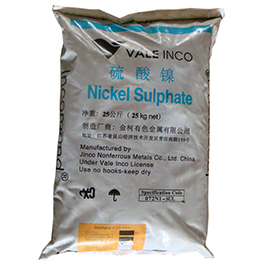Surface Treatment
Home-Product-Surface Treatment-Plating

Nickel Sulfate
Shape appearance:
Blue-green tetragonal crystal.
Product Usage:
Mainly used in the electroplating industry, it is the main nickel salt for electroplating nickel and chemical nickel, and also the source of metal nickel ions. It can dissociate nickel and sulfate ions during the electroplating process. In the production of hardened oil, it is a catalyst for oil hydrogenation. It is used in the pharmaceutical industry as a catalyst for the oxidation reaction of vitamin C. The inorganic industry is used as the main raw material for the production of other nickel salts such as nickel ammonium sulfate, nickel oxide, and nickel carbonate. In the printing and dyeing industry, it is used to produce phthalocyanine blue complexing agent, which is used as a coal dyeing agent for vat dyes. In addition, it can also be used to produce nickel-cadmium batteries.
Blue-green tetragonal crystal.
Product Usage:
Mainly used in the electroplating industry, it is the main nickel salt for electroplating nickel and chemical nickel, and also the source of metal nickel ions. It can dissociate nickel and sulfate ions during the electroplating process. In the production of hardened oil, it is a catalyst for oil hydrogenation. It is used in the pharmaceutical industry as a catalyst for the oxidation reaction of vitamin C. The inorganic industry is used as the main raw material for the production of other nickel salts such as nickel ammonium sulfate, nickel oxide, and nickel carbonate. In the printing and dyeing industry, it is used to produce phthalocyanine blue complexing agent, which is used as a coal dyeing agent for vat dyes. In addition, it can also be used to produce nickel-cadmium batteries.
- Previous:
- Industrial Nitric Acid
- Next:
- Carbon core
Product Description
Warehousing and transportation:
Avoid rain and hot sun during transportation. Be careful when loading and unloading to prevent damage to the package. In case of fire, water, sand, carbon dioxide fire extinguishers can be used to fight the fire. Store in a cool, ventilated warehouse. The temperature of the warehouse should not exceed 30℃, and the humidity in the warehouse should preferably not exceed 85%. Keep away from fire and heat sources. should be kept away from oxidizer, do not store together. The storage area should be equipped with suitable materials to contain the leakage. The storage area should be equipped with leakage emergency treatment equipment and suitable storage materials.
Safety Precautions:
Closed operation, strengthen ventilation. Operators must undergo special training and strictly abide by operating procedures. It is recommended that operators wear self-priming filter dust masks, chemical safety glasses, anti-poison penetration overalls, and rubber gloves. Avoid generating dust. Avoid contact with oxidants. When handling, load and unload with care to prevent damage to packaging and containers. Equipped with leakage emergency treatment equipment. Empty containers may be harmful residues. The operator wears labor protection equipment during use or transportation.
Avoid rain and hot sun during transportation. Be careful when loading and unloading to prevent damage to the package. In case of fire, water, sand, carbon dioxide fire extinguishers can be used to fight the fire. Store in a cool, ventilated warehouse. The temperature of the warehouse should not exceed 30℃, and the humidity in the warehouse should preferably not exceed 85%. Keep away from fire and heat sources. should be kept away from oxidizer, do not store together. The storage area should be equipped with suitable materials to contain the leakage. The storage area should be equipped with leakage emergency treatment equipment and suitable storage materials.
Safety Precautions:
Closed operation, strengthen ventilation. Operators must undergo special training and strictly abide by operating procedures. It is recommended that operators wear self-priming filter dust masks, chemical safety glasses, anti-poison penetration overalls, and rubber gloves. Avoid generating dust. Avoid contact with oxidants. When handling, load and unload with care to prevent damage to packaging and containers. Equipped with leakage emergency treatment equipment. Empty containers may be harmful residues. The operator wears labor protection equipment during use or transportation.






 13603024855
13603024855 Follow us
Follow us